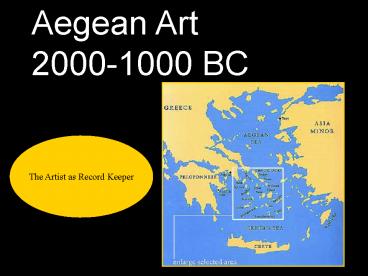Aegean Art PowerPoint PPT Presentation
Title: Aegean Art
1
Aegean Art 2000-1000 BC
The Artist as Record Keeper
2
- New Vocabulary
- Idol
- Megaron
- Fresco
3
- Aegean Civilizations flourished before Greek
Civilization - Includes Cycladic, Minoan, Mycenaean cultures
- Written about in Homers Iliad and from Greek
myths - Knowledge of these cultures is a lot less than of
Egypt and Near East - No aid from written records
- Linear B- 2000 BC developed in Minoan
culture-usually palace inventories and records-
has not helped decipher religion and art
4
- Cycladic Art- 2600-1100 BC
- Have left hardly any trace apart from modest
stone tombs - Large marble idols buried with the dead-earliest
life-sized sculpture of the female form - Idols are nude female figure with arms folded
across the chest - Have not seen anything like it before- not like
earlier fertility figures
Cycladic Idol, 2500-1100 BC
5
Palace of Minos, Knossos, Crete c.1500 BC
Minoan Art
6
- Minoan Art -
- Very fractured style- as if sudden change came to
the civilization more than once- external forces? - But artwork reflects a culture that is peaceful
and playful with no hint of threat - Until 2000 BC. Still living at Neolithic level-
then created an urban civilization with palaces
and trade (with Egyptians) - Most information comes from Knossos, the Palace
of Minos- vast enough to survive in Greek legends
as the home of the Minotaur - Exterior was not impressive- low ceilings and no
unified and monumental style - Porticos, staircases and air shafts gave it an
airy feel - Columns were made of wood- and were very distinct
7
The Queens Megaron, Palace of Minos, Knossos
Rulers were probably not ruler-gods like Near
East and Egypt Military subjects are absent from
the art Palace was used for administration and
commercial activity- presence of storerooms and
workshops
8
- Little known about religious life
- Centered on sacred places
- Chief deity was female snake goddess
- No temples, lacked cult statues
- Few religious subjects in art
- Snakes associated with male fertility
- Secular looking- fashion
- Crete has few snakes, so the snake idea was
probably imported- but no snake goddesses have
been discovered outside of Crete
Snake Goddess c.1600 BC
9
The Toreador Fresco, C. 1500 BC
- Marine life is seen in all artwork- fluid
movement is more important than drama - Shows a game, not a bull fight- two of the
figures are female-playful like dolphins- very
original - Bull is a sacred animal
- Ambiguous meaning- not sure if one scene, or
three different actions
10
Pottery- designs drawn from plant and animal
life- fish, shells, octopuses- very similar to
the wall paintings- flowing and rhythmic
Octopus Vase, c.1500 BC
11
- Slim, muscular men carrying farming tools
- Narrative not as important as the rhythm
- Energetic and physical
- Humorous in nature
Harvester Vase, 1550-1500 BC
12
- Mycenaen Art-
- Southeast shores of Greek mainland (1600-1100 BC)
- first thought to have come from Crete because of
similar art characteristics, but probably were
early Greek tribes - Tombs were central to the culture
Treasury of Atreus, 1300-1250 BC
13
- 1600 BC, began to build elaborate tombs- buried
dead on deep shafts covered with beehive
structures - More elaborate tombs were only found in Egypt
from around the same time period
Interior, Treasury of Atreus
14
- Alongside royal dead, were masks of gold and
silver - Similar in purpose to Egyptian death masks
- Lots of personal equipment found such as vessels,
jewelry, weapons
Rhyton in the shape of a lion 1550 BC
15
Vaphio Cup, 1500 BC
16
How do we tell the difference between Minoan and
Mycenaen?
Vaphio Cup c. 1500 BC
17
- Hilltop fortresses, defensive walls of huge
stone- - quite unlike Minoan
- Lions Gate of Mycenae- massive stone relief over
doorway- - guardians of the gate- tense muscular,
symmetrical design suggests influence from Near
East - Center of the palace at Mycenae was the audience
hall called the Megaron- not much remains but
looks back to simple house plans of earlier times
The Lion Gate, 1250 BC
Hilltop fortresses, defensive walls of huge
stone- quite unlike minoan Lions Gate of Mycenae-
massive stone relief over doorway- guardians of
the gate- tense muscular, symmetrical design
suggests influence from near east Center of the
palace at Mycenae was the audience hall called
the megaron- not much remains but looks back to
simple house plans of earlier ti
18
- There is no Mycenaen temple architecture that
remains (or was even suggested) - Palaces did contain small shrines
- Religion was probably influenced by Minoan,
Greek- but its hard to figure this out - Not sure who this group of deities is
- The divine child is a popular ancient myth
- A familiar view of deities is seen here for the
first time
Three Deities, 1500-1400 BC

